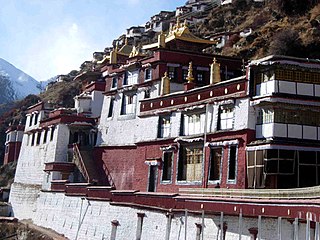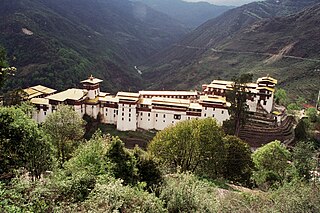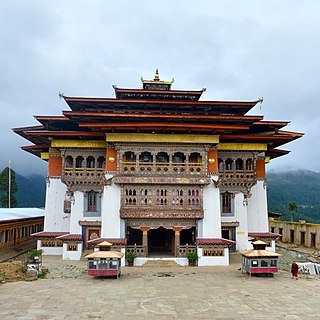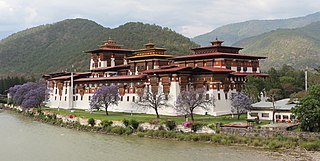
Thimphu is the capital and largest city of Bhutan. It is situated in the western central part of Bhutan, and the surrounding valley is one of Bhutan's dzongkhags, the Thimphu District. The ancient capital city of Punakha was replaced as capital by Thimphu in 1955, and in 1961 Thimphu was declared as the capital of the Kingdom of Bhutan by the 3rd Druk Gyalpo Jigme Dorji Wangchuck.

Cradled in the folds of the Himalayas, Bhutan has relied on its geographical isolation to protect itself from outside cultural influences. A sparsely populated country bordered by India to the south, and China to the north, Bhutan has long maintained a policy of strict isolationism, both culturally and economically, with the goal of preserving its cultural heritage and independence. Only in the last decades of the 20th century were foreigners allowed to visit the country, and only then in limited numbers. In this way, Bhutan has successfully preserved many aspects of its culture, which dates directly back to the mid-17th century.

Dzong architecture is a distinctive type of fortress architecture found mainly in Bhutan and Tibet. The architecture is massive in style with towering exterior walls surrounding a complex of courtyards, temples, administrative offices, and monks' accommodation.

Paro District is a district (dzongkhag), valley, river and town in Bhutan. It is one of the most historic valleys in Bhutan. Both trade goods and invading Tibetans came over the pass at the head of the valley, giving Paro the closest cultural connection with Tibet of any Bhutanese district. The dominant language in Paro is Dzongkha, the national language.

Sera Monastery is one of the "great three" Gelug university monasteries of Tibet, located 1.25 miles (2.01 km) north of Lhasa and about 5 km (3.1 mi) north of the Jokhang. The other two are Ganden Monastery and Drepung Monastery. The origin of its name is attributed to a fact that during construction, the hill behind the monastery was covered with blooming wild roses.

The Palcho Monastery or Pelkor Chode Monastery or Shekar Gyantse is the main monastery in the Nyangchu river valley in Gyantse, Gyantse County, Shigatse Prefecture, Tibet Autonomous Region, China. The monastery precinct is a complex of structures which, apart from the Tsuklakhang Monastery, also includes its Kumbum, believed to be the largest such structure in Tibet, that is most notable for its 108 chapels in its several floors and the old Dzong or fort.

Drigung Thil Monastery is a monastery in Maizhokunggar County, Lhasa, Tibet founded in 1179. Traditionally it has been the main seat of the Drikung Kagyu tradition of Tibetan Buddhism. In its early years the monastery played an important role in both religion and politics, but it was destroyed in 1290 by Mongol troops under the direction of a rival sect. The monastery was rebuilt and regained some of its former strength, but was primarily a center of meditative studies. The monastery was destroyed after 1959, but has since been partly rebuilt. As of 2015 there were about 250 resident monks.

Paro is a town and seat of Paro District, in the Paro Valley of Bhutan. It is a historic town with many sacred sites and historical buildings scattered throughout the area. It is also home to Paro Airport, Bhutan's sole international airport.

Bhutanese architecture consists of Dzong and everyday varieties. Dzongs in Bhutan were built as fortresses and have served as religious and administrative centers since the 17th century. Secular lordly houses emerged as a distinct style in the late 19th century, during a period of relative peace in Bhutan. Throughout its history, Bhutan has mainly followed the Tibetan tradition of Buddhist architecture.

Rinpung Dzong is a large dzong - Buddhist monastery and fortress - of the Drukpa Lineage of the Kagyu school in Paro District, Bhutan. It houses the district Monastic Body and government administrative offices of Paro Dzongkhag. It is listed as a tentative site in Bhutan's Tentative List for UNESCO inclusion.

Tashichhoedzong (བཀྲ་ཤིས་ཆོས་རྫོང) is a Buddhist monastery and fortress on the northern edge of the city of Thimphu in Bhutan, on the western bank of the Wang Chu. It has traditionally been the seat of the Druk Desi, the head of Bhutan's civil government, an office which has been combined with the kingship since the creation of the monarchy in 1907, and summer capital of the country. In old British documents, it is known as Tassisudon.
It was built by the first Dharma Raja, who also founded the Lho-drukpa sect of Buddhism, which has remained the distinctive sect of Bhutan. The correct transliteration of the vernacular name—Bkrashis-chhos-rdzong, meaning "the fortress of auspicious doctrine"—is, according to Dr. Graham Sandberg, Tashichhoidzong.

The Gangteng Monastery, generally known as Gangtey Gonpa or Gangtey Monastery, is an important monastery of Nyingmapa school of Buddhism, the main seat of the Pema Lingpa tradition. located in the Wangdue Phodrang District in central Bhutan. The Monastery, also known by the Gangten village that surrounds it, is in the Phobjikha Valley where winter visitors – the black-necked cranes – visit central Bhutan to roost, circling the monastery three times on arrival and repeating this circling when returning to Tibet. The Monastery's history traces to the early 17th century and back to the prophecies made by the well-known Terton Pema Lingpa in the late 15th century.

Paro Taktsang, is a prominent Himalayan Buddhist sacred site and the temple complex is located in the cliffside of the upper Paro valley in Bhutan.

The Tango Monastery is a Buddhist monastery located 14 kilometres (8.7 mi) to the north of the capital city of Thimphu in Bhutan, near Cheri Mountain. It was founded by Phajo Drugom Zhigpo in the 13th century and built in its present form by Tenzin Rabgye, the 4th Temporal Ruler in 1688. In 1616, the Tibetan lama Shabdrung Ngawang Namgyal meditated in its cave. The self-emanated form of the wrathful Hayagriva is deified in the monastery. It belongs to the Drukpa Kagyu School of Buddhism in Bhutan.

Trongsa Dzong is the largest dzong fortress in Bhutan, located in Trongsa in Trongsa district, in the centre of the country. Built on a spur overlooking the gorge of the Mangde River, a temple was first established at the location in 1543 by the Drukpa lama, Nagi Wangchuk son of Ngawang Chhojey. In 1647, his great-grandson Shabdrung Ngawang Namgyal, constructed the first dzong to replace it, called Chökhor Rabtentse Dzong with a shorter version of Choetse Dzong. It was enlarged several times during the 18th century; the Chenrezig Lhakang was built in 1715 and a whole complex, including the Maitreya (Jampa) temple, was added in 1771. The dzong has since been repaired on several occasions; it was damaged during the 1897 Assam earthquake and underwent extensive renovation in 1927 and 1999.

The Punakha Dzong, also known as Pungthang Dewa chhenbi Phodrang, is the administrative centre of Punakha District in Punakha, Bhutan. Constructed by Ngawang Namgyal, 1st Zhabdrung Rinpoche, in 1637–38, it is the second oldest and second-largest dzong in Bhutan and one of its most majestic structures. The dzong houses the sacred relics of the southern Drukpa Lineage of the Kagyu school of Tibetan Buddhism, including the Rangjung Kharsapani and the sacred remains of Ngawang Namgyal and the tertön Pema Lingpa.

Lhuentse Dzong is a dzong and Buddhist monastery in Lhuentse District in eastern Bhutan. It lies on the eastern side of the Kuri Chhu and is perched on a spur at the end of a narrow valley.

Phallus paintings in Bhutan are esoteric symbols, which have their origins in the Chimi Lhakhang monastery near Punakha, the former capital of Bhutan. The village monastery was built in honour of Lama Drukpa Kunley who lived in the 15-16th century and who was popularly known as the "Mad Saint" (nyönpa) or “Divine Madman” for his unorthodox ways of teaching, which amounted to being bizarre and shocking.

The Gongkar Chö Monastery or Gongkar Dorjé Monastery is located in Gonggar County, Lhoka Province, Tibet Autonomous Region near Gonggar Dzong and Lhasa Gonggar Airport.
Kangpar Gewog is a gewog of Trashigang District, Bhutan. Kangpara Gewog, along with Thrimshing Gewog, comprises Thrimshing Dungkhag (sub-district). Kangpara is one of the remotest gewogs under Trashigang Dzongkhag(district). The gewog is 341.9 square kilometers and shares borders with other gewogs like Gomdar, Thrimshing, Shongphu, Khaling, Shingkhar Lauri and Merak. Kangpara is popular for housing some sacred monasteries like Lamai Goenpa, Sikhar Goenpa et al., and is also popular for their belief in deities like Ama Jomo and Meme Dangling.

















